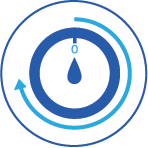How does Duke Energy's net metering work?
Duke Energy's net metering program allows customers who generate electricity from their own solar panel system to offset their energy costs. Net metering participants receive bill credit from Duke Energy for the excess energy generated by their solar panel system.
Where does Duke Energy offer net metering?
Duke Energy's service territory covers regions of Florida, Indiana, Kentucky, North Carolina, Ohio, and South Carolina. Net metering is offered to all customers throughout the territory.
-
- State
- Florida
- Program available?
- Yes
- Program website
- Website
-
- State
- Indiana
- Program available?
- Yes
- Program website
- Website
-
- State
- Kentucky
- Program available?
- Yes
- Program website
- Website
-
- State
- North Carolina
- Program available?
- Yes
- Program website
- Website
-
- State
- Ohio
- Program available?
- Yes
- Program website
- Website
-
- State
- South Carolina
- Program available?
- Yes
- Program website
- Website
What are Duke Energy’s rates and prices for net metering?
Rates and prices for Duke Energy net metering vary from state to state.
Florida
Duke Energy has three tiers of generating facilities for net metering contracts:
- Tier 1 Generating Facilities are less than or equal to 10 kilowatts (kW)
- Tier 2 Generating Facilities are between 10 kW and 100 kW
- Tier 3 Generating Facilities are between 100kW and 2000kW
Most residential customers fall under the Tier 1 Generating Facilities category. You can view the current electricity rates in Florida on Duke Energy's website.
Indiana
In Indiana, Duke Energy has three levels of generating facilities for net metering contracts:
- Level 1 systems are less than or equal to 10 kW
- Level 2 systems are less than 2 MW
- Level 3 covers all systems greater than 2 MW
Most residential customers in Indiana will install Level 1 systems. Duke Energy Indiana's current rate for Residential and Farm Electric Service is approximately 11 cents/kWh, and also requires a connection charge of $9.40/month. You can view the current electricity rates in Indiana on Duke Energy's website.
Kentucky
Duke Energy Kentucky has two tiers for net metering systems:
- Level 1 includes installations sized at 30kW and under that use a UL 1741 compliant inverter
- Level 2 includes installations greater than 30kW
Most residential solar panel systems are Level 1. You can view the current electricity rates in Kentucky on Duke Energy's website.
North Carolina
In North Carolina, solar PV systems fall into one of two categories:
- Residential systems, which must be 20 kW or less
- Nonresidential systems, which are capped at 1,000 kW
You can view the current electricity rates in North Carolina on Duke Energy's website.
Ohio
Duke Energy has three levels of generating facilities for net metering contracts. Level 1 inverter based projects up to 25kW. Levels 2 and 3 are non-inverter projects greater than 25kW. Most residential customers have Level 1 systems. Net metering credits are determined at Rider RE, Retail Energy rate which recovers costs related to supplying energy.
South Carolina
In South Carolina, solar PV systems fall into one of two categories:
- Residential systems, which must be 20 kW or less
- Nonresidential systems, which are capped at 1,000 kW
Net metering credits are allocated monthly at a rate of 10 to 11 cents/kWh. Unused credits are paid out annually in March - you can view the current electricity rates in South Carolina on Duke Energy's website.
What is Duke Energy's net metering cap?
Net metering caps are set by individual states. As a result, Duke Energy’s net metering cap varies depending on the state in which it is operating.
-
- State
- Florida
- Cap %
- None
- Cap (MW)
- None
-
- State
- Indiana
- Cap %
- 1% of peak summer load
- Cap (MW)
- 64 MW (2016)
-
- State
- Kentucky
- Cap %
- 1% of single-hour peak load
- Cap (MW)
- 9 MW (2016)
-
- State
- North Carolina
- Cap %
- None
- Cap (MW)
- None
-
- State
- Ohio
- Cap %
- None
- Cap (MW)
- None
-
- State
- South Carolina
- Cap %
- 2% of retail peak demand
(averaged over previous 5 years) - Cap (MW)
- 62 MW
What will happen to my Duke Energy net metering bill credits?
Your excess net metering bill credits from Duke Energy will be treated differently depending on where you live.
Florida
Any excess energy generation at the end of the billing month is credited to the customer's energy consumption for the next billing cycle. At the end of each calendar year, Duke Energy credits the customer for any unused net metering credits at an annual rate based on the COG-1 tariff.
Indiana
When a solar panel system generates more energy than supplied by Duke Energy, the customer is credited the excess kWh in the next billing cycle. These credits never expire, but if the customer discontinues net metering, all excess credits are granted to Duke Energy. The customer is separately responsible for paying the monthly connection charge.
Kentucky
When a solar panel system generates more energy than supplied by Duke Energy, the customer is credited the excess kWh in the next billing cycle. These credits do not expire, but if the customer discontinues net metering, all excess credits are granted to Duke Energy. The customer is still responsible for paying the monthly customer charge.
North Carolina
When a customer's solar panel system generates more energy than supplied by Duke Energy, the customer is credited the excess kWh during next month's billing period. Any accrued credits will be reset to zero on May 31st each year and cannot be used to offset Basic Facilities Charges or Demand Charges. Customers are separately responsible for the monthly Basic Facilities Charge.
Ohio
When a customer's solar panel system generates more energy than they use in a month, the customer receives net metering credits, which are accrued over a 12 month period. Customers can request a refund in writing from the utility which will be valued at the Rider RE rate.
South Carolina
In South Carolina, excess energy credits not used to offset electricity needs in the current month can be carried forward to the next billing month. Any credits remaining at the March billing period are paid out to the customer, at which point net metering credits are reset to zero.
Does Duke Energy offer other solar incentives?
Duke Energy offers rebates to North Carolina customers who want to install a solar panel system. For homeowners, the program offers a $0.60/Watt rebate for systems up to 10 kilowatts. The benefit is equivalent to $3,600 for a 6 kilowatt (kW) system. Nonresidential customers also have access to rebates of $0.50/Watt to $0.75/Watt. In some states, Duke Energy also offers programs that enable its customers to support renewable energy in other ways:
- GoGreen Indiana gives customers the ability to support the development of green power sources such as solar and wind in Indiana by purchasing a minimum of two 100 kWh blocks of green power for $1.80/month.
- GoGreen Kentucky gives customers the opportunity support green power such as solar and wind by purchasing a minimum of two 100 kWh blocks of green power for $2/month.
- NC GreenPower is a nonprofit, statewide organization that gives North Carolina customers the ability to contribute $4/month to the organization which is split with $2 purchasing 50 kW of energy produced from green sources and $2 supporting the installation of solar demonstration projects at NC K-12 schools.
- GoGreen Ohio helps customers support green power such as solar and wind by purchasing a minimum of two 100 kWh blocks of green power for $2/month.
- South Carolina offers a Shared Solar Program for qualified customers, including those who live in multifamily housing or rent homes and all those who may not otherwise have access to solar energy.
What are Duke Energy's solar interconnection policies and costs?
Interconnection is the process of physically connecting a generating facility (renewable energy source) to Duke Energy’s electric power system. Each state within Duke Energy’s territory requires an application to connect. The application fees and requirements vary by state.
Florida
For interconnection for customers with Tier 1 solar panel systems (generating 10 kW or less), there is no application fee, disconnect switch or insurance requirement associated with this system size. Duke Energy will replace the customer's current meter with a bidirectional meter that is capable of recording any excess energy generation for the purpose of calculating net metering credits. Tier 2 and Tier 3 Generating Facilities have application fees of $240 and $750, respectively, and require insurance of $1 million and $2 million.
-
- System Type
- Tier 1
- System size
- > 10 kW
- Application Fee
- None
- Insurance Requirement
- None
-
- System Type
- Tier 2
- System size
- 10-100 kW
- Application Fee
- $240
- Insurance Requirement
- $1 million
-
- System Type
- Tier 3
- System size
- 100-2,000 kW
- Application Fee
- $750
- Insurance Requirement
- $2 million
Indiana
For interconnection for customers with Level 1 solar panel systems (up to 10kW in size) there is no application fee. For Level 2 and Level 3 applications there are $50 and $100 application fees respectively plus a $1/kW and $2/kW. Most residential solar panel systems are Level 1. In addition to the Level 1 application, customers must also include an electrical one-line diagram, equipment specifications, and a disconnect switch. After installation of the system there may be an inspection. The deadline to submit the final Interconnection Request is October 1 to ensure the system is connected before the end of the year.
-
- System Type
- Level 1
- System size
- > 10 kW
- Application Fee
- None
-
- System Type
- Level 2
- System size
- 10-100 kW
- Application Fee
- $50, plus $1.00/kW
-
- System Type
- Level 3
- System size
- 100-2,000 kW
- Application Fee
- $100, plus $2.00/kW
North Carolina
The interconnection process varies based on project size. Most residential customers will have a system that is sized at 20 kW or less, in which case customers must first submit a Pre-Application request with a nonrefundable $300 fee. The customer must then complete the online Interconnection Request signed by the customer requesting interconnection along with a $100 nonrefundable processing fee which includes an electrical one-line diagram and insurance certification
The state of North Carolina also requires customers to file a Report of Proposed Construction with the North Carolina Utilities Commission and provide the Report's docket number to Duke Energy. After these documents are submitted, Duke Energy will grant approval to install the solar panel system at which time a disconnect switch will be installed.
After the system is installed and inspected, the customer must submit a Certification of Completion form at which time Duke Energy gives the customer permission to operate contingent that the Duke meter is set.
Ohio
Most residential customers have solar panel systems less than 25 kW and fall under the interconnection process for Level 1. To start, a customer must submit a Pre-Application Report request with a nonrefundable $300 fee. The customer must then complete the Duke Energy Ohio Short Form Application for Interconnection and pay a $50 application fee. The Application must also include an electrical one-line diagram, insurance certification, and equipment certification. Duke Energy also requires the installation of a disconnect switch.
After solar panel system installation, an inspection may be required. Once the inspection is complete, the customer will receive a confirmation letter from Duke Energy indicating that the solar panel system is complete.
South Carolina
For residential customers, the interconnection process is for projects less than or equal to 20kW. Customers must first submit a Pre-Application request with a nonrefundable $500 fee. The customer must then complete the online Interconnection Request, including both an electrical one-line diagram and insurance certification, along with a $100 nonrefundable processing fee. Duke Energy will then grant contingent approval to install the solar panel system along with the required disconnection switch.
Once installed, a copy of the inspection and the Certification of Completion form must be sent to Duke Energy in order for the customer to receive permission to operate the system once the meter has been set. Duke Energy must receive a complete interconnection request by October 1 to ensure the project is complete by December 31 of the current year.
Looking for the best solar companies in Duke Energy territory?
You wouldn’t buy a car without comparing a few options first.Shouldn’t solar be the same?
Compare multiple solar quotes on EnergySage
With EnergySage, you can compare your solar options when you
receive quotes from the best local solar installers near you.
Get a quick estimate of your savings with solar
Find out how affordable solar is for your home with our Solar Calculator, or simply register your property today to get quotes.




